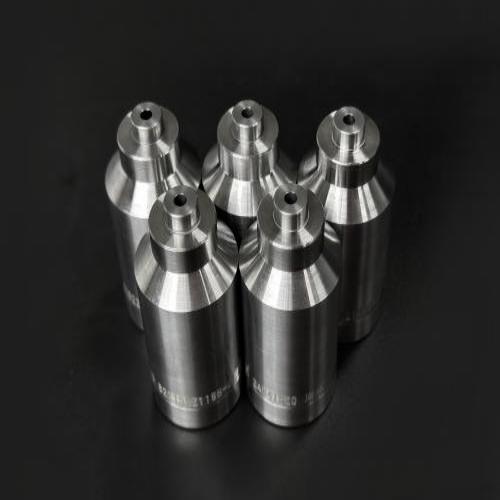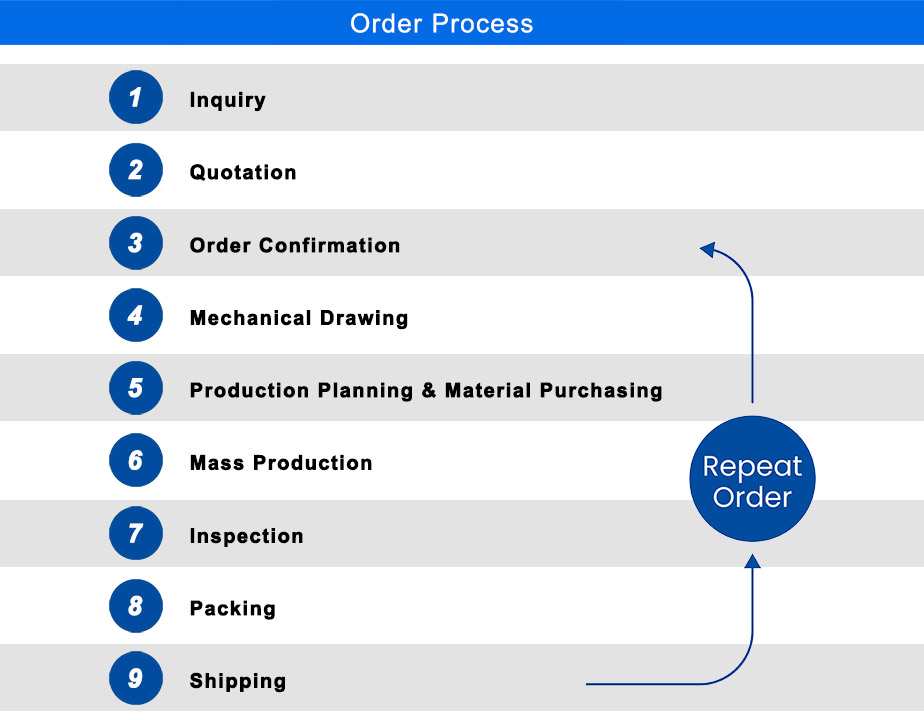Punch&Dies is popular for its high degree of customizability. It is capable of customizing holes of varying shapes and sizes to meet specific needs for a wide range of materials and products. Whether it's for automotive manufacturing, appliance production or building renovation, the Punch Die provides precise punching solutions. Their efficiency, durability and flexibility make mass production easier and more efficient. Productivity and safety are further enhanced through customized automated punching systems. The customizable nature of punching dies makes them an essential tool for many industries.

High efficiency: the punching die can complete the punching of a large amount of material in a short period of time, which significantly improves the production efficiency. For mass production, the high efficiency of punching dies can significantly reduce production costs.
Accuracy: Punching dies are usually manufactured with very high precision to ensure that the size, location and shape of the punched hole meets the design requirements. This accuracy is critical for products that require high precision holes.
Durability: Punching dies are usually made of abrasion- and corrosion-resistant materials to maintain stable performance under harsh operating conditions. Meanwhile, the structural design of the punching die is optimized to withstand greater impact and pressure, ensuring stable work over a long period of time.
Flexibility: The punching die can be customized according to different needs and is suitable for processing holes of various shapes, sizes and materials. In addition, the punching die can also be used in conjunction with other molds to achieve more complex processing needs.
Safety: Punching dies usually offer a high level of safety during operation. For example, some punching molds are equipped with safety protection devices that can prevent the operator from being injured during operation. In addition, the maintenance and repair of perforating dies is relatively simple and easy, which can reduce equipment failure rates and repair costs. Customizability:
Customizability:
Shape customization: Punching dies can be customized to produce holes of various shapes and sizes according to the design requirements of the product. Whether it is round, square, oval or other special shapes, all of them can be realized by the punching die.
Structure customization: The structure of the punching die can also be customized. Depending on the processing needs of the product, different punching die structures can be designed to meet different processing requirements. For example, some punching dies may need to punch holes in multiple locations at the same time, while others may need to achieve different depths of punching.
Automation Customization: As automation technology continues to evolve, punching dies can be used with automated equipment for more efficient processing. By customizing automated punching systems, functions such as automated feeding, positioning and punching can be automated to further increase productivity.
Our punching tools are designed for fast, repetitive operations, significantly reducing production time. Ideal for mass production lines, they help increase output while lowering unit costs.
Manufactured with micron-level precision, our dies ensure perfect hole alignment, shape consistency, and tight tolerances—crucial for applications requiring high dimensional accuracy.
Made from high-speed steel, carbide, or premium tool steels, our punches and dies withstand high-pressure, high-temperature environments, offering long-lasting performance with minimal wear.
Our punch and die sets can be custom-engineered to meet your exact application needs, including:
Hole shape and size
Punching depth and structure
Automation compatibility
Our dies integrate safety features and are designed for easy maintenance, reducing the risk of downtime and improving operator safety.
Punch & Dies are widely used in:
Automotive: Chassis components, body panels, brackets
Electronics: Connector pins, enclosures, heat sinks
Aerospace: Precision structural components
Appliances & HVAC: Housing units, vent holes, sheet frames
Construction: Metal panels, custom fittings
Typical operations include:
Cutting – Cutting sheet metal to specific shapes, such as creating metal sheets or washers
Punching – Creating holes in sheet metal, such as bolt holes or vent holes
Forming – Shaping metal sheets into specific curved or concave forms, like automobile body panels
Our Punch & Dies are manufactured from high-strength materials such as:
High-Speed Steel (HSS)
Carbon Tool Steel
Carbide
These materials provide excellent wear and impact resistance, ensuring long-lasting durability and consistent performance under high-pressure and high-temperature conditions.
The production of Punch & Dies involves sophisticated machining processes, including:
CNC Milling
Grinding
Wire EDM
Electrical Discharge Machining (EDM)
These processes ensure that every punch and die meets micron-level precision, guaranteeing accuracy and consistency in your stamped parts.
To improve performance and extend the service life of our Punch & Dies, we offer advanced surface treatments such as:
Nitriding
Titanium Plating
Chrome Plating
These treatments enhance surface hardness, corrosion resistance, and wear resistance, ensuring the durability of your tooling.

What are Punch & Dies?
Punch & Dies are tools used in the stamping process to cut, punch, and form sheet metal.
What industries use Punch & Dies?
They are used in the automotive, electronics, aerospace, appliance, and construction industries to form and process metal components.
What materials are used in Punch & Dies?
Common materials include high-speed steel (HSS), carbon tool steel, and carbide, which provide high wear and impact resistance.
How do I select the right material for Punch & Dies?
Consider the hardness of the material to be processed, the type of stamping process, and the frequency of use to ensure durability and precision.
What are the manufacturing processes for Punch & Dies?
Manufacturing processes include CNC milling, grinding, wire EDM, and electrical discharge machining, which ensure high precision tools.
What are the surface treatments for Punch & Dies, and why are they important?
Surface treatments like nitriding, titanium plating, and chrome plating increase the hardness and corrosion resistance of the tool, extending its service life.
Punch Die Product Information | |
Product Name | Punch Die |
Brand Name | Donglong |
Place of Origin | Dongguan, Guangdong, China |
Specification | Customized on Request |
Customization | Material, size, shape, convex and concave marking, coating, laser engraving mark and packing are all customizable. |
Product Material | Carbide.ASP23 Vanadis.CPMRTXM4.SKD11SKD61HSSA2M2D2SUJ2.S45C.ect |
Standard | DIN ANSI BS JIS |
Tolerance | ±0.002mm |
Surface Treatment | TiCNTiN,Aitain,Ticrnnitriding Black oxygened Black coating etc available |
Polishness | Close to Ra0.2 Hardness Depends on material(HRC60~94) |
Hardness | Depends on material(HRC60~94) |
Shaping Mode | Grinding, wire cutting, EDM, cnc machining, cnc turning, cnc Milling |
Application | Machinery Parts and Molds |
Material for Core of Wire Drawing Dies | ||||||
Grade | WC+Other | Co | Grain Size | Density | Hardness | TRS |
(±0.5%) | (±0.5%) | (g/cm³) | (HRA)±0.5 | (N/mm²) | ||
KG5 | 88 | 12 | Medium | 14.31 | 88.3 | 340 |
KG6 | 86 | 14 | Medium | 14.12 | 87.3 | 320 |
EA65 | 82 | 18 | Coarse | 13.75 | 85 | 300 |
EA90 | 76 | 24 | Coarse | 13.22 | 82.8 | 270 |
ST6 | 85 | 15 | Coarse | 13.8 | 86 | 270 |
ST7 | 80 | 20 | Coarse | 13.4 | 85.3 | 270 |
VA80 | 80 | 20 | Coarse | 13.58 | 84 | 280 |
VA90 | 78 | 22 | Coarse | 13.39 | 82.5 | 240 |
VA95 | 75 | 25 | Coarse | 13.12 | 81.5 | 220 |
Material for Casing of Punch Die | |||
Material | Hardness (HRC) | Features | Applications |
H13 | 59-61 | H13 is a chromium molybdenum hot work steel with exceptional hot hardness and abrasion resistance, general hardness, and toughness. | Used for extrusion dies, forging dies, stamping tools, etc. |
SKD11 | 58-61 | SKD11 tool steel has good wear resistance and size ability after heat treatment. | Used for tensile dies, cold extrusion dies, first punch holder, etc. |
SKD61 | 43-53 | SKD61 steel is a high-grade die casting die. It has heat shock resistance, heat deformation resistance, heat fatigue resistance. | Used for heat work dies, cold heading dies, second punch holders. |